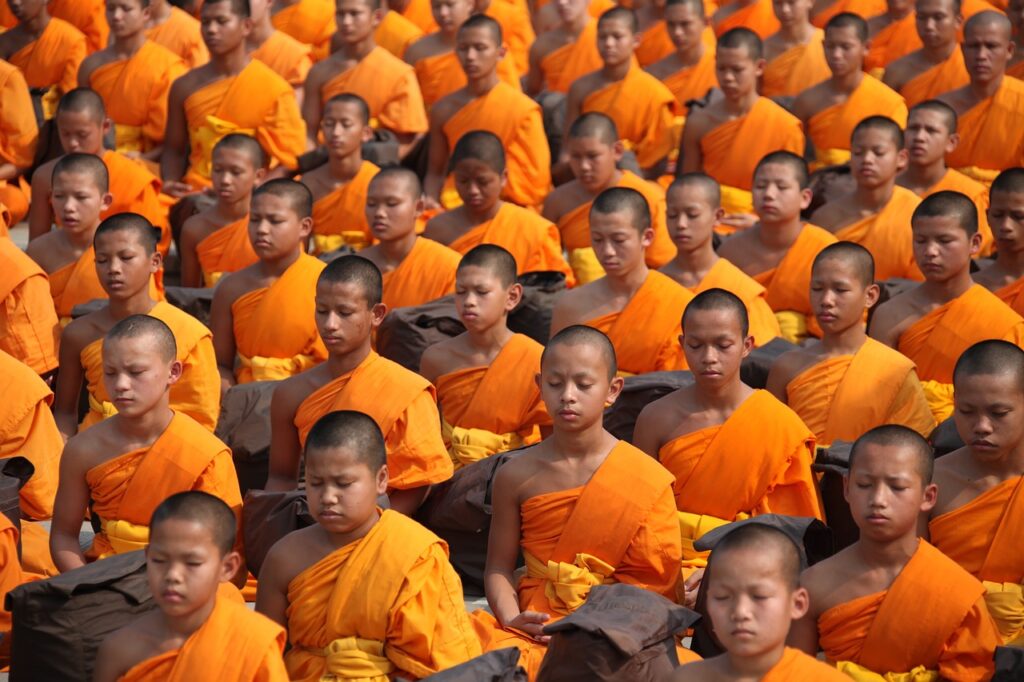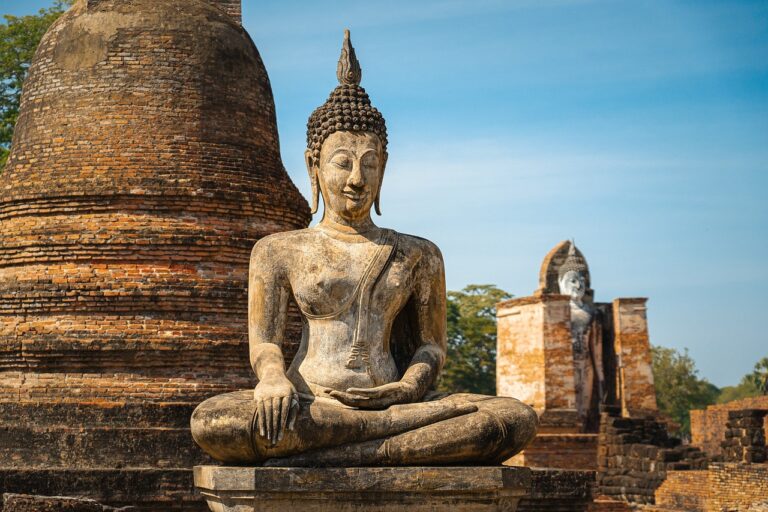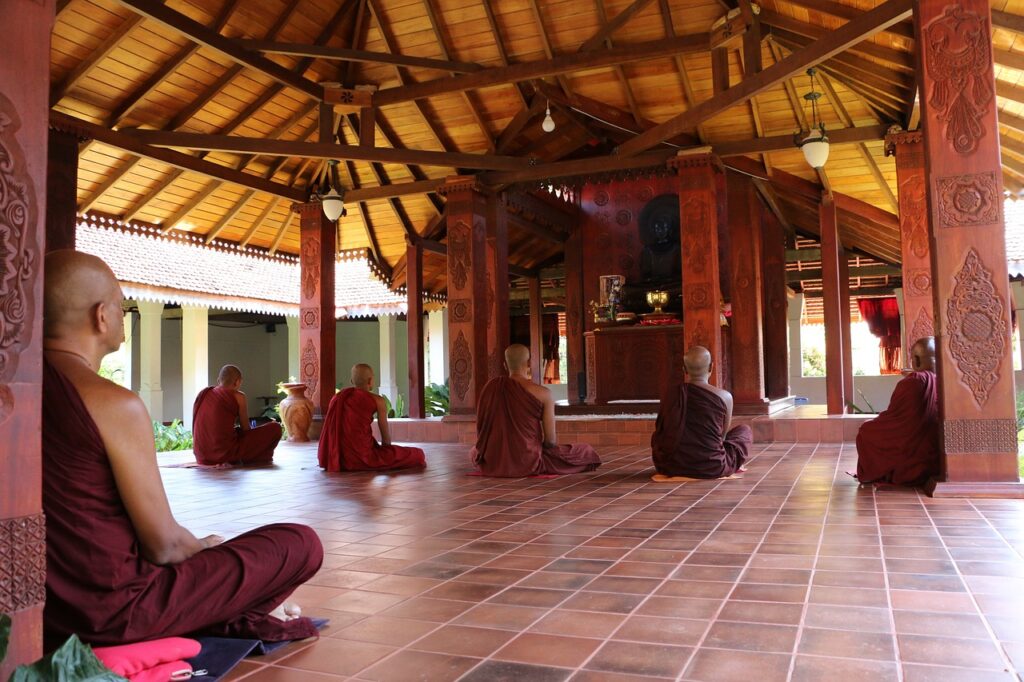What is meditation?
Understanding the essence of stillness

What is meditation?
“Those who travel outward seek completeness in things;
those who gaze inward find sufficiency in themselves.”
1. Intro
In a world filled with constant activity and noise, the practice of meditation emerges as a refuge of peace. A refuge available to me, to you, to anyone. It is a ‘journey’ that invites us to turn inward, explore the depths of our consciousness, and discover a profound sense of innate peace and clarity.
Meditation emerged as a means of seeking deeper understanding and connecting to the Self, the divine, and inner peace. It is a versatile practice that transcends cultural boundaries. I won’t delve much deeper into the origins of meditation here, I’ll save that for another article. But to understand what meditation is, it is quite helpful to understand how it evolved, so I’d recommend reading the upcoming article: How did Meditation Begin? as well.
In this article, I will discuss the essence of meditation. To engage in any kind of practice, one needs to know what it is one is doing, or not doing in this case. The article starts with the terminology of ‘meditation’, it then continues with the essence of meditative practice, and ends with the ‘goal’ of meditation. All in all, this will give you a good idea of what meditation entails, which will help you in navigating your own complex inner landscape. PS: If you’re not interested in the terminology of the word ‘Meditation’ I’d suggest skipping to ‘3. What is Meditation?’ straight away. Now without further ado, let’s get into it!

2. The term: ‘Meditation’
2.1 Dhyāna / Jhāna
The English term ‘meditation’ is derived from the Latin term ‘meditatio‘ from the verb ‘meditari‘, meaning: “to think, contemplate, devise, ponder”. The term ‘meditation’ was introduced as a translation for Eastern spiritual practices, referred to as dhyāna (Sanskrit) / Jhāna (Pali) in Hinduism and Buddhism. ‘Dhyāna‘ comes from the Sanskrit root ‘dhyai’, meaning to contemplate- or as we would now call it: meditate. The term (and the practice) Dhyāna has spread throughout Asia over the centuries. During its travels, it transformed slightly wherever it went. You are probably familiar with the Japanese interpretation of the term, known as: ‘Zen’. Zen originated from the Chinese ‘Chan School’, which in turn derived its name from the Sanskrit ‘Dhyāna’. Lots of terminology, I know, I hope you’re still with me.
2.2 Confused Westerners
However, defining ‘meditation’ is not that easy, as it covers a wide range of different practices from various Eastern traditions. We just use the term ‘meditation’ to heap all kinds of these spiritual practices together. We aren’t as attuned to the minute differences between these practices. Westerners decided to just use one word for all these contemplative practices to make it easier. The problem is that there is quite a bit of difference between these meditative practices, and calling all these practices ‘meditation’ can cause confusion. The Buddhists differentiate for instance between two main categories of meditative practices: Samatha (calm abiding) and Vipassana (insight). While the Yoga/Vedic tradition talks about Pratyahara, Dharana, and Dhyana as different categories of meditative practices.
This confusion about the term is also prevalent in the scientific community which is still yet to find a consensus on the precise meaning of the term: “There remains no definition of necessary and sufficient criteria for meditation that has achieved universal or widespread acceptance within the modern scientific community”. A 2009 study noted a “persistent lack of consensus in the literature” and a “seeming intractability of defining meditation” (Wiki).
2.3 One term to rule them all
Having just one term for all these practices may have seemed convenient, but it is mainly confusing us now. If you sign up for a meditation class, or watch a meditation on Youtube, without any further information, you don’t know what you’re going to get. You might be attending a basic concentration practice, or you might find yourself at a deep insight practice. You might be facing a wall with your eyes closed or walking in circles staring at the ground. We have created one term to encapsulate a big variety of practices, one term to rule them all.
To be fair, just like defining the overarching term ‘meditation’ isn’t an easy job, categorizing the many different contemplative practices from the East isn’t a walk in the park either. There are hundreds of traditions and schools, and within the same tradition, there are various practices and theories. Not to mention that each teacher will also teach these in a slightly different way than another teacher. To top things off there are people, like me, who try their best to pass on the wisdom properly, but inevitably there will be differences in interpretation and understanding. It is therefore quite logical that you may get confused about what meditation exactly entails.
Even though there are MANY different meditation techniques and traditions, they all point to the same universal stillness within. Accessible to anyone, anywhere. Since I can’t go into detail on the intricacies of various meditation techniques in this article, I’ll stick to the universality of the practice, the commonality of the practice that transcends traditions. I will now give you a basic, workable definition, so you will know: ‘What is meditation?’.

3. What is meditation?
3.1 Familiarizing with the Mind
As I’ve just said: different traditions/schools/teachers will have differing theories/viewpoints on meditation. It is therefore worth mentioning where my interpretation of meditation comes from. My understanding is mostly influenced by Tibetan Buddhism (Karma Kagyu & Nyingma traditions), as well as my time as a monk in a Thai Theravadan tradition, known as Dhammakaya.
Meditation is a contemplative practice intended to help you become familiar with the mind and the essence of the mind, which is awareness. To become familiar with the ways to bring forth the qualities that are present in that awareness: compassion, loving-kindness & wisdom. To purify the mind of its defilements, which come in the form of anger, greed, and delusion. At its core, meditation is a practice that involves focusing the mind and disidentifying from the usual stream of thoughts that occupy our consciousness. It is a practice where we observe our thoughts, emotions, and sensations without immediate judgment or reaction. That is how we become familiar with the mind.
Meditation is often confused for forcing yourself not to think, which you will find, is counterproductive. The mind doesn’t like to be forced into meditation, it responds better to gentle guidance. Meditation is a deliberate engagement with our mental landscape: to feel and understand what is going on inside. It is the practice of becoming present. Presence is about being able to rest in awareness. It is about becoming aware of the simple fact that you are aware. Recognizing awareness, and maintaining that recognition. Aware of the thoughts, emotions and feelings that rise up within you continuously. You learn to let them be as they are, not being carried away from the present by them (video).
3.2 Flow
Meditation is closely related to the nowadays widespread concept of ‘Flow’. Flow is a state where you are so caught up in the one single activity you are performing that you forget everything else going on around you. It can be sports, work, reading, or anything where you feel like you are ‘in the zone’. Your thoughts, emotions, and even time seem to pass by very easily and naturally. Your sense of self may even subside as you are completely immersed in the one thing you are doing. The same sort of total absorption and ease is exactly what the practice of meditation points to. A state where the egoïc self subsides and a feeling of peace, calm and clarity comes up in your consciousness. Thoughts, emotions and sensations organically pass by without any attachment or aversion towards any of them, Life just seems to flow effortlessly.
3.3 Analogies
The analogy of a river is used in Buddhism to help you better understand meditation. If you find yourself inside of a river (the usual stream of thoughts and emotions) you can’t see the river, you are caught up inside it. Meditation allows you to clearly see the thoughts and emotions (/ the river). When you are aware of the river, you are already out of the river, it no longer has a grip on you. There is no need to block the river; don’t fight the thoughts and emotions, the simple awareness of their presence, while letting them be, creates some distance between you and the river. Between you and the thoughts and emotions that constantly spring up. If this confuses you, try watching the video featured above.
I have heard many different analogies all pointing to the same essence of meditation:
- You are an observer sitting at the side of the road, watching the cars (thoughts & emotions) go by. Letting them be as they are, not chasing them like a madman. Just resting quietly while noticing them, not actively trying to get rid of any one of them.
- You are the sky (the awareness), which is always there. Clouds come and go (thoughts & emotions), ever-changing, but the vast sky will always be there, right behind them. You are that vast sky, not the fleeting thoughts and emotions.
- You are the ocean, identifying as the waves on the surface (mind objects), not realizing your own innate depth and vastness. I could go on with these analogies, but I think you get the picture.
3.4 Letting go
Through meditation we learn to let go. Not wanting things to be different, but accepting the way things are. The mind will constantly bring forth thoughts and emotions. Instead of fighting the cars, waves and clouds, the more sane way to ‘deal’ with them is to accept them as they are. To watch the spectacle as a neutral observer. Through acceptance, the thoughts and emotions lose the grip they have on you. No longer will you be caught up in them as you recognize you are the calm, vast sky. You are the space allowing these things to come forth.
Recognizing yourself as the unmoving field of awareness in which all these transitory things like thoughts, emotions, sense perceptions come in and pass by, is the key recognition. Everywhere you are and at anytime you have access to this calm awareness behind the thoughts, feelings and emotions. Gradually you will start seeing they are mostly involuntary and ever-changing, not something worthy of identifying with. Most people aren’t aware of this. The more ego-identified, and thus conditioned and unconscious a person is, the more he feels he is drowning in the river, chasing cars and clouds like a madman. If only he knew what meditation could do for him.

4. The 'Goal' of Meditation
4.1 Enjoying the mind
The main purpose of meditation is not to fight the mind and its fabrications but to work with the mind and befriend it so that you can enjoy its innate qualities. The innate qualities of the mind are believed to be: awareness, compassion, loving kindness and equanimity. This entails that your mind already has these qualities within but we often can’t see or feel it because of the layers of dirt and dust that have overgrown it. These layers come in the form of conditioning, conceptualization, and judgment, which cloud the mind and its innate qualities.
Another way to look at it is that these qualities are not innate but have to be cultivated. Considering this view, one has to purify the mind of its defilements: anger, greed, and delusion, while cultivating the more positive qualities such as compassion, wisdom and joy. Whether you believe these qualities of mind are innate or have to be cultivated doesn’t matter, the practice is the same.
“Meditation is about calming the mind and finding joy. Unconditional joy, which means external circumstances in your life don’t have to be a certain way for you to feel peaceful and joyful.”
4.2 Enlightenment / Nirvana
According to most spiritual traditions, the final ‘goal’ of Life in general is to become Enlightened / Liberated. It is to ‘reach’ what the Buddhists call ‘Nirvana’. The Buddhists believe in reïncarnation, and through liberation one is freed from the karmic cycle of rebirth. That is the ultimate aim: to free oneself from all worldly attachments and desires. This brings about the end of suffering through deeply understanding the nature of Reality. When one is completely free from all desire, one is liberated. There is no more clinging to anything, even to life itself. It doesn’t mean you disintegrate, it means you are completely at one with Life. Meditation is the key factor to ‘achieve’ this, as it dispels ignorance/delusion and thereby helps you see reality more clearly.

4.2.1 No need to believe
If you don’t believe in reïncarnation, karma, Nirvana and all that stuff, don’t worry, you don’t have to. If you’re here to simply learn meditation to destress a bit, this may not be for you right now, fair enough. The Buddha’s teachings (The Dharma) includes some very deep stuff and some teachings may not resonate with you. I am not a missionary that tries to convince you of something.
But it is important to distinct between what doesn’t resonate with you and what feels uncomfortable because you feel there is truth in it. The Dharma (Buddha’s teachings) contains lessons about Life, Reality and the Self that tend to make the conditioned mind uneasy and wanting to squirm away. I’ve found the reason for that reaction within me being the truth about myself being conveyed in such a way that it hits so close to home it starts feeling uncomfortable. The Ego feels threatened by it. However, through contemplation and Self-enquiry I’ve found the mind games slowly subsiding, as I am seeing them more clearly for what they are: insubstantial, conditioned patterns.
For me, I’ve found that to deeply understand meditation, and really deepen my practice, Buddhist teachings offer invaluable insight. It might do the same for you. However, there is no need to blindly believe anything, the teachings are meant to be put rigorously to the test by attempting to understanding them yourself. Don’t believe the Buddha, put his teachings to the test. In fact, that’s what he said. He invited people to come and see, not to come and believe.
4.3 The success paradox of meditation.
In the Western world, meditation is often used as a means to an end, to become free of thought, to achieve relaxation, or to be able to focus better. These are all benefits that meditation can indeed bring you. But striving for them in your meditation practice is actually what gets in the way of attaining them. The benefits of meditation can be compared to the growth of a flower. A flower blooms on its own, your job is simply to take care of the soil, sunlight, and watering. You don’t have to be concerned with the growing process itself, that happens naturally. In the case of meditation, that means to practice consistently and diligently, without focusing on the results, they will come on their own accord. Trust the process.

5. SUmmary
To shortly summarize: Meditation in popular usage, is used to encompass many different types and styles of meditation and concentration exercises. These practices can include almost anything that is claimed to train the attention of the mind or to teach calm or compassion. By creating this all-encompassing term, we haven’t made understanding this practice much easier. But to be fair, the inner world and the ‘journey’ within are very difficult to understand-, let alone putting them into words..
So what is meditation? It is about familiarizing ourselves with the mind. By becoming aware of the fact that we are aware of something, we bring in a new level of consciousness. A level that sees and knows. By maintaining that awareness as the observer of what is going on during meditation, you realize you are not the thinking entity, you are the knowing entity. You are the space that allows things to come into existence. Whether they be thoughts, emotions, or sensory perceptions, they come into your field of awareness. Meditation is about 1. Recognizing the open field of non-judgmental awareness, 2. Recognizing you are that field, and 3. Remaining that recognition.
It is hard to grasp what impact such a realization will have on your daily life. Apart from the obvious scientifically backed results, which I will lay out in a future article, you’ll find it enriches your life far beyond that. I invite you to find out for yourself. What I can spoil is that: your mind is going to be blown away.
Thank you!
That was it, I hope you enjoyed the article. You now have some theoretical know-how about meditation to help you in your practice. The best thing to do now is meditate if you have a few minutes. If you don’t know how, it’s quite helpful to start with some guided meditations. Personally I love this one for instance: video (15 min) or choose a shorter one: video (6 min). In the next article I will explain a bit more on: ‘How to meditate‘. Wishing you much peace and joy.
Explore more
Books I highly recommend:
– The Power of Now
– The Joy of Living
– Buddhism: Plain and Simple
– The Art of Happiness
Practice


